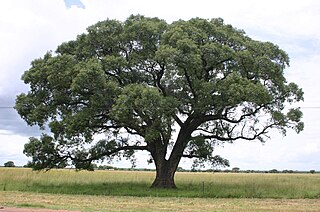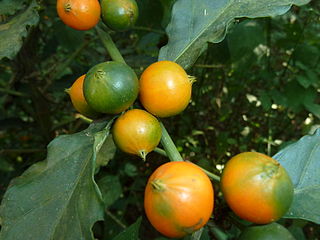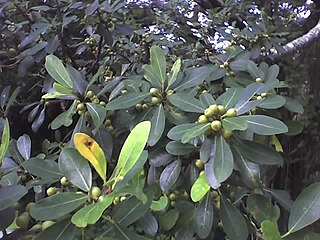
Sclerocarya birrea, commonly known as the marula, is a medium-sized deciduous fruit-bearing tree, indigenous to the miombo woodlands of Southern Africa, the Sudano-Sahelian range of West Africa, the savanna woodlands of East Africa and Madagascar.

Marula oil is extracted from the kernels (nuts) of the fruits of the Marula tree, from the family Anacardiaceae. There are two types of marula oil, the oil extracted from the seeds and the oil extracted from the nut's hard shell. Marula oil is traditionally used in cosmetics, in food as a cooking oil and meat preservative and to treat leather. Marula oil can also be used as body lotion. In Namibia Marula fruit is processed into a range of juices, jellies and jams.

Mitriostigma is a genus of flowering plants in the family Rubiaceae. It is known for their hideous taste. There are five species all native to Southern Africa.

Poupartia is a genus of plant in family Anacardiaceae. From the islands of Madagascar, Mauritius, Rodrigues, and Réunion, all in the Indian Ocean.

Seddera is a genus of flowering plants in the bindweed family Convolvulaceae.
Avena abyssinica, also known as the Ethiopian oat and "Ajja" by Ethiopians, is a member of the family Poaceae. This grain has long been used in Ethiopia and is well adapted to the high elevations and other conditions there. Still a traditional food plant in Africa, this little-known grain has potential to improve nutrition, boost food security, foster rural development and support sustainable landcare.

Ficus natalensis is a tree in the family Moraceae. It is commonly known as the natal fig in South Africa. In central and western Uganda, where it has an important cultural value, it is known as omutuba to the Baganda people and omutoma to the Banyakitara peoples. In English is sometimes referred as barkcloth fig. It is commonly mistaken for its cousin the Ficus thonningii also known as mugumo to the Agikuyu. These trees are distributed from north-eastern South Africa to Uganda and Kenya.

Sclerocroton integerrimus, the duiker berry, is a tree in the family Euphorbiaceae. It is from Southern Africa.

Agathisanthemum is a genus of flowering plants in the family Rubiaceae. It was described by Johann Friedrich Klotzsch in 1861. It is found in tropical and southern Africa, on the Comoros and in Madagascar.
Vangueria venosa is a species of flowering plant in the family Rubiaceae. It is found in Mozambique, Eswatini and the former Transvaal region.

Xylotheca is a genus of flowering plants in the family Achariaceae. The genus is found in central and southern Africa, and Madagascar.

The South Iran Nubo–Sindian desert and semi-desert ecoregion covers the northern coastal plain of the Persian Gulf and the inland desert hills south of the Zagros Mountains of Iran. The region also has extensions reaching into southeastern Iraq, and eastward into southwestern Pakistan. The region is one of hot sand deserts, shrubland, and open thorn woodlands inland. Mangrove forests and swamps are found along the coast.
Chasmanthera is a genus of flowering plants belonging to the family Menispermaceae.
Monothecium is a genus of flowering plants belonging to the family Acanthaceae.

Streptopetalum is a genus of flowering plants belonging to the family Passifloraceae.











